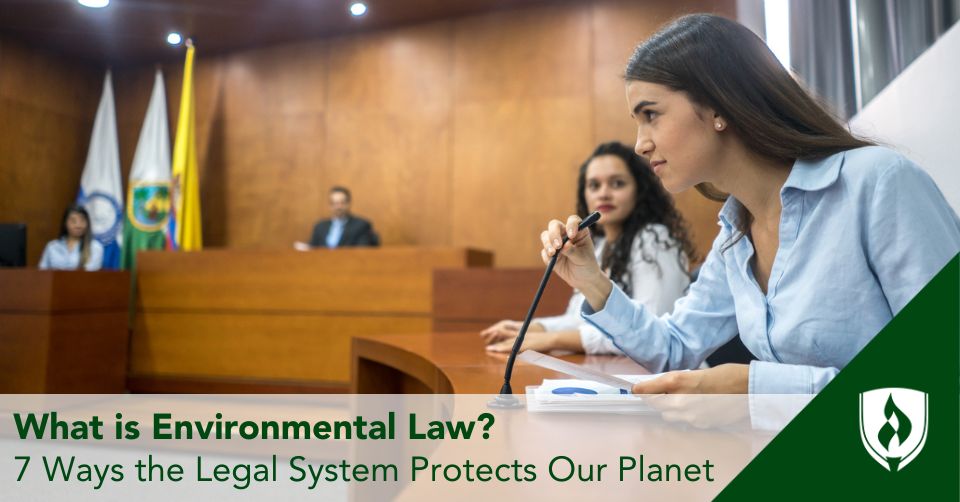What is Environmental Law? 7 Ways the Legal System Protects Our Planet
By Noelle Hartt on 05/02/2024

Environmental law exists to develop and enforce protections that keep the earth (and all who live on it) safe. Even if you never come face-to-face with, say, a sea turtle, human actions today could impact sea turtle populations tomorrow—which then can impact more species in the chain, leading to planetary changes.
A healthy relationship between humans and the earth could make all the difference in how long we get to be here as a species. This is why we have environmental law.
What is environmental law?
Environmental law is a category of legal policy and regulation that focuses on the natural world, natural resources and human interaction with the planet. It can range from regulating the use of limited natural resources to protecting air and water from pollution. It can include efforts to maintain and preserve natural spaces threatened by human activity as well as litigating how organizations can make environmental claims.
At the start, environmental law was an extension of public health efforts in the latter half of the 1900s. Pretty quickly, however, environmental law morphed into an independent field to protect human health and nonhuman nature.1
What does environmental law protect?
Of course, our environment is comprised of many different elements, from the soil we walk on to the vegetables we eat to the oxygen we breathe. Accordingly, environmental law is sizable field, as policymakers and scientists have continued working together throughout the years to determine the best strategies for preserving our planet.
“Generally, environmental law focuses on preserving the air, water, and natural resources around us,” states the Library of Congress Law.2 And there are a few key areas environmental law highlights to do just that!
1. Protecting our stratosphere
Environmental laws have accounted for air pollution control since 1963, when the federal government passed the Clean Air Act (CAA).3 Since that time, the Environmental Protection Agency (EPA) has continually increased its efforts to protect our atmosphere and ozone layer—and for good reason. Protecting our stratosphere is integral to supporting human health—not to mention, the health and safety of plant and animal species, too.
The American Lung Association states that “ozone air pollution remains a serious threat to public health,” but assures us “the Clean Air Act has been working,” as the number of US residents living in counties with failing grades for ozone smog decreased by 19 million in 2023 alone.4
This is a perfect example of how environmental law is about protecting human health just as much as that of the planet. Afterall, you can’t have one without the other.
The Clean Air Act has paved the way for additional environmental laws that regulate emissions at the state, local and tribal levels, according to the Department of Energy’s Office of Environment, Health, Safety & Security.
2. Protecting public lands (and the natural resources they provide)
Ever wonder who’s in charge of what goes on—and what’s not allowed—on public lands? There’s a whole federal bureau for it—the US Bureau of Land Management (BLM). Federal laws coming from this bureau are all about the huge swaths of public land in this country.
There are three additional main players at the federal level who help to manage the impact of human activities on these public spaces:
- Department of Agriculture’s Forest Service
- Department of the Interior’s Fish and Wildlife Service (FWS)
- Department of the Interior’s National Park Service (NPS)
Together with the BLM, these government entities create environmental regulations and manage nearly all federally-owned public land.5
In addition to public land use and planning, the BLM has specific programs dedicated to:
- Energy and minerals
- National conservation lands
- Recreation and visitor services
- Wild horse and burros
- Lands and realty
- Law enforcement
- Fire
- Cultural heritage
- Paleontology
- Wildlife conservation
- Plant conservation and restoration
- Forest and woodlands
On top of this, each state also runs its own Department of Natural Resources (DNR). These organizations also create regulations around the use of public land.
3. Protecting endangered species
Bald eagles. American alligators. Whooping cranes. All these creatures have made remarkable comebacks from the brink of extinction, thanks to the protections they received through the Endangered Species Act of 1973.6
As the National Oceanic and Atmospheric Administration (NOAA) Fisheries explains, the Endangered Species Act “provides a framework to conserve and protect endangered and threatened species and their habitats both domestically and abroad. This includes wildlife, fish and plants.
The act denotes protocols for adding and removing species to the list of protected populations. It also provides guidance for government agencies to receive financial assistance and work together to implement recovery plans for the identified endangered species.
Based on the progress we’ve seen so far, it’s a pretty important piece of legislation. And it’s working.
4. Protecting wildlife populations and their homes
Did you know our country has over 570 wildlife refuges, marine national monuments, conservation areas and waterfowl production areas? Together, these sites make up our National Wildlife Refuge System, which the Fish & Wildlife Service manages.
To help protect our wildlife and natural resources, the service also establishes guidelines for activities like hunting, fishing and more.
5. Drinking water and aquatic species
You might have heard of the Clean Water Act (AKA CWA, AKA the Federal Water Pollution Control Act of 1948.) It may go by many names, but this piece of legislation has been fundamental for environmental regulation.
Only half a century ago, water pollution was so toxic that wildlife was forced to leave its natural habitat. Today, however, thanks to the changes and cleanup made possible through this act, the EPA reports, “waters that were once polluted are now boatable, fishable, and even swimmable.”7
A huge part of the Clean Water Act’s success comes from the National Pollution Discharge Elimination System (NPDES), a byproduct of the Clean Water Act that gave the EPA authority to “set wastewater standards for industry and water quality standards for all contaminants in surface waters” in order to better control pollution.
We also have the Safe Drinking Water Act (SDWA), which provides even stricter regulations for above ground and underground fresh water sources. These pieces of environmental law work together to protect the water cycle on our planet.
6. Protecting our beautiful forests
The US is home to roughly eight percent of the planet’s forests, making us “the fourth largest forest estate in the world,” with “about 304 million hectares of forest land,” according to former Chief of the United States Forest Service (USFS) of the Department of Agriculture, Thomas L. Tidwell.8
The National Forest Management Act in federal law allows us to prevent deforestation while still harvesting natural resources from our National Forests.
7. Controlling hazardous substances
Pollution is, arguably, our planet’s #1 enemy; it causes substantial environmental harm and threatens human health around the globe.9 The proper removal of hazardous substances is something we just can’t afford to leave up to chance. And with the Comprehensive Environmental Response, Compensation, and Liability Act (CERCLA), we don’t have to.
Through CERCLA, the EPA may receive a Superfund from the federal government to clean up hazardous waste sites.10 Additionally, this act authorizes the EPA to “seek out those parties responsible” for unlawful pollution and recover the cost of cleanup “from financially viable individuals and companies once a response action has been completed.”
These efforts can involve an environmental impact assessment to figure out the extend of environmental contamination. This is one of the areas an environmental lawyer might get especially involved in since improper disposal of hazardous wastes can be a byproduct of companies hoping to save money.
Who’s involved in environmental law?
There are so many key players involved in environmental law, from federal agencies to local governments and even private law firms specializing in environmental issues. And, since issues with our planet are, well, planetary, there are plenty of international environmental laws and international environmental agreements that require political figures as well as the buy-in of entire countries.
It’s a rewarding field to work in, because while setbacks and bureaucracy can be maddening, knowing that your work helps protect the natural world for everyone on earth is pretty satisfying. Law firms practicing environmental law might focus on one particular area of environmental management, environmental pollution control or specific types of organizations (like mining or technology manufacturing) or even specific governmental agencies.
Many different careers have the potential to make a meaningful impact by challenging environmental harms and setting new legal standards to protect our planet.
Environmental law job titles
Many law firms—whether they specialize in environmental law or another area—employ a full staff of professionals, all of whom work together to address pressing legal issues. Private law firms dedicated to environmental concerns may have career options for...
- Environmental lawyers12
- Records clerks
- Legal secretaries
- Accountants13
- HR managers
- IT managers
- Paralegals14
The future of environmental law
As you can see, there’s a lot of legislation and regulation for the environment. But since the health of our planet is so important, there’s still plenty of work happening now to put further protections in place.
For example, there are currently 32 open lawsuits against oil companies that aim to hold them accountable for the environmental issues that stem from fossil fuel use.11 And last year, the Supreme Court’s ruling in Sackett v. Environmental Protection Agency redefined the criteria for wetlands to receive federal protection. As a result, millions of acres of wetlands are no longer protected by the Clean Water Act, a development that has environmental lawyers and scientists scrambling to keep wetlands safe.
Since the Sackett decision, the Biden Administration joined the UN’s Freshwater Challenge, which aims to restore nearly one billion acres of wetlands by 2030, according to The Union of Concerned Scientists.
Can you see yourself working in environmental law?
Do you want a career that allows you to make a meaningful difference? Are you committed to the fight against climate change? Do issues like pollution control, wildlife protection and resource conservation weigh heavily on your mind?
Environmental law helps to protect people, the planet and all life on earth. If you want to help keep the ocean clean, stop icebergs from melting, or defend people living in areas threatened by changing climates or disappearing populations of plants and animals, environmental law could be a perfect place to do so.
If you said, “yes,” to any of the above, you have the values for a rewarding future in environmental law. And the best part is this: you don’t even need to go to law school to begin your journey on this fulfilling career path.
A paralegal professional can specialize in environmental law and help make a positive impact on cases concerning our planet’s health. They work side by side with environmental attorneys and advocate for change in the intersection of environmental science and justice.
Learn more about this exciting career option! Take a look at 8 Types of Paralegals Who Specialize in Different Fields of Law.
1Britannica, Levels of environmental law, (accessed April 2024), Environmental law - Pollution, Regulations, Conservation | Britannica
2Library of Congress Research Guides, Environmental Law: A Beginner’s Guide, (accessed April 2024), Introduction - Environmental Law: A Beginner's Guide - Research Guides at Library of Congress (loc.gov)
3United States Environmental Protection Agency, Evolution of the Clean Air Act, (accessed April 2024), Evolution of the Clean Air Act | US EPA
4American Lung Association, A Nation’s Air Quality Divided: New Report Reveals Growing Disparities in Exposure to Air Pollution, (Apr. 19, 2023), https://www.lung.org/media/press-releases/state-of-the-air-2023
5U.S. Department of the Interior Bureau of Land Management, BLM Programs, (accessed April 2024), Programs | Bureau of Land Management (blm.gov)
6U.S. Fish & Wildlife Service, Endangered Species Act, (accessed April 2024), Endangered Species Act | U.S. Fish & Wildlife Service (fws.gov)
7United States Environmental Protection Agency, Summary of the Safe Drinking Water Act 42 U.S.C. §300F et seq. (1974), (accessed April 2024), Summary of the Safe Drinking Water Act | US EPA
8Tom Tidwell, Chief of the United States Forest Service (USFS) of the Department of Agriculture, Address at the World Conservation Congress Honolulu, HI (Sep.4, 2016), State of Forests and Forestry in the United States | US Forest Service (usda.gov)
9Cleveland Clinic, How Pollution Impacts your Health, (Feb.28, 2023), How Pollution Impacts Your Health (clevelandclinic.org)
10United States Environmental Protection Agency, What is Superfund?, (accessed April 2024), What is Superfund? | US EPA
11Alex Brown, After a long slog, climate change lawsuits will finally put Big Oil on trial, (Apr.4, 2024), After a long slog, climate change lawsuits will finally put Big Oil on trial • Stateline
12Rasmussen University does not offer any programs that lead to the career outcome of Environmental Lawyer
13Rasmussen University’s Accounting Certificate, Accounting Associate’s degree, and Accounting Bachelor’s degree programs are not designed to prepare graduates for any state-issued professional license or certification. These Accounting programs doe not meet all educational prerequisites for licensure as a Certified Public Accountant (CPA) in any state
14Rasmussen University’s Paralegal Associate’s degree and Paralegal Certificate programs are not designed to prepare graduates for any professional certifications or state-issued licenses




